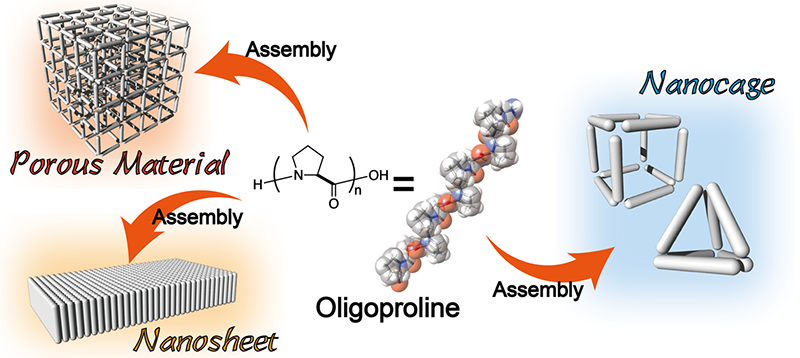Research
The Matsubara group study the “supramolecules” which are formed by the molecular self-assembly. By assembling molecules, supramolecules provide interesting properties that do not exist in the single molecules. Therefore, supramolecules have potentials for the application to various novel materials. In our group, we aim to create innovative nanomaterials and soft materials by conducting a series of experiments, synthesis of organic molecules → preparation of supramolecules (self-aggregates) → evaluation of the structure and function. Currently, our main projects are the following.
KEYWORDS: Supramolecules, Self-Assembly, (Bio)organic Chemistry, Peptides, Nanomaterials, Photosynthesis
Supramolecular Nanomaterials Using Peptides (Oligoprolines) as Building Blocks
Oligoproline is a type of peptide possessing a rigid, helical, and rod-like structure. We have focused on the oligoproline as a small rod (1D) and create various supramolecular nanostructures such as nanosheet (2D), nanocage (3D), and MOF-like nanostructures (3D) by self-organization of the nanorod. In particular, we are currently studying to construct supramolecular cages using oligoproline derivatives and attempting its application for nanoreactors (catalysis) and drug delivery system.

Photofunctional Material Based on Chlorophyll-Peptide Conjugates
Chlorophyll is a green photosynthetic pigment which possesses various optical properties such as light-harvesting, photo-emission, and generation of reactive oxygen species (ROS) by photo-irradiation. Peptides have the ability to change self-assembling properties depending on the external environments, e.g. heat, pH, and ion concentration. By combining the optical properties of chlorophyll and the self-assembling property of peptides, we are constructing novel photofunctional materials. Specifically, we are creating pH-responsible photosensitizers for photodynamic therapy (PDT) and an artificial light-harvesting antenna that efficiently collects solar energy.





